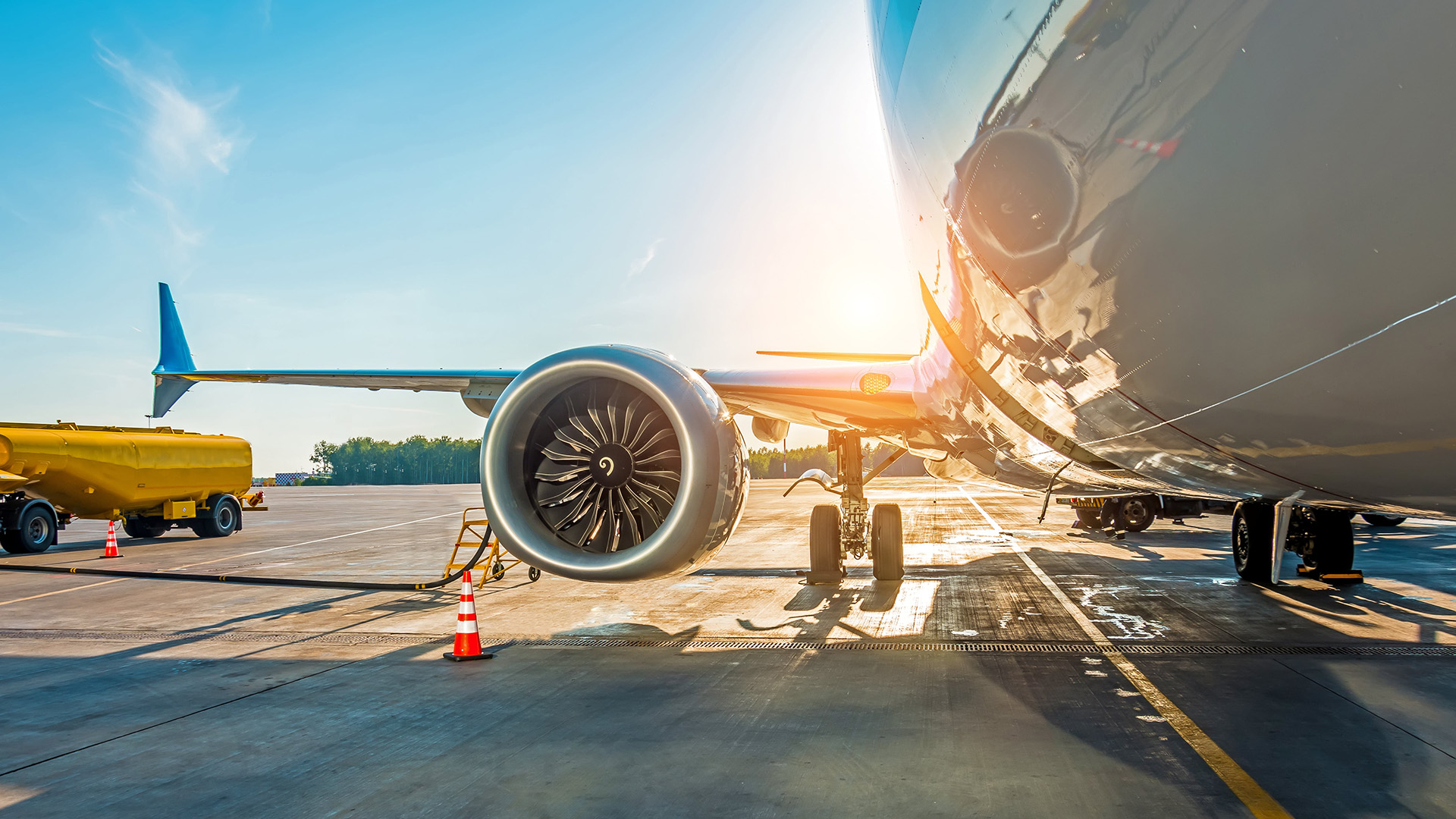In April 2024, the UK Government published details of its sustainable aviation fuel mandate (the UK SAF Mandate) and launched a consultation on proposals for a revenue certainty mechanism to support UK sustainable aviation fuel (SAF) production.
The UK SAF Mandate, which is binding on aviation fuel suppliers, includes key policy parameters such as a cap on fuel made from hydroprocessed esters and fatty acids (HEFA), a power-to-liquid (PtL) mandate separate to the main SAF obligation, and a buyout price as an alternative method of compliance where fuel suppliers are unable to secure SAF.
The consultation seeks views on the policy design for a revenue certainty mechanism in order to stimulate the development of the UK’s own SAF industry, with the aim that this mechanism will be introduced by the end of 2026.
In this article we look at how the UK SAF Mandate will work and the options for a revenue certainty mechanism being consulted on, and how they might impact the UK aviation industry.
Background
The wider transport sector is the UK’s largest emitting sector, accounting for 27% of the UK’s greenhouse gas (GHG) emissions. SAF plays a key role in the UK Government’s Jet Zero Strategy to reach net-zero UK aviation emissions by 2050, while alternative technologies such as hydrogen or battery-powered aircraft remain unavailable for use in commercial aviation. In 2023, the EU published its ReFuel Regulation to accelerate the use of SAF on flights departing from EU airports, following the roll-out in the US of significant tax incentives for SAF producers under the Inflation Reduction Act.
Internationally, governments looking to promote the use of SAF at their airports have had the dilemma as to whether to follow the US approach to SAF – the “carrot” of tax incentives to encourage increased production and supply – or the “stick” approach of the EU’s SAF mandate (ReFuelEU), which requires fuel suppliers to supply, and airlines to uplift, increasing proportions of SAF for use on flights departing from EU airports. The UK will join a number of other countries in taking (primarily) the latter approach, with SAF mandates already implemented or in their early stages in countries such as Sweden, Norway, France, Singapore and Japan. The UK will also, however, look to support domestic SAF production by introducing a revenue certainty mechanism, recognising that uncertainty over the future cost of SAF and an undefined market price constitutes a key barrier to the development of the UK SAF industry.
After two rounds of consultation, the UK Government published the UK SAF Mandate on 25 April 2024, which will undergo parliamentary scrutiny and is due to become effective from 1 January 2025.
How does the UK SAF Mandate work?
Setting progressive targets into 2030 and beyond
The UK SAF Mandate sets progressive targets on aviation fuel suppliers to provide increasing amounts of SAF from 2025 to 2040. Starting in 2025, 2% of the jet fuel supplied in the UK must be SAF (approximately 230,000 tonnes – compared to the 64,000 tonnes1 of SAF produced in 2023). The annual target will increase year-on-year to reach the published 10% SAF target in 2030, and 22% in 2040.
The UK SAF Mandate will operate as a tradeable certificate scheme under which the supply of SAF is rewarded in proportion to its GHG emissions reductions. These certificates can be used to discharge a fuel supplier’s obligation under the UK SAF Mandate or be sold to other fuel suppliers.
The UK SAF Mandate is binding on aviation fuel suppliers, but it will also impact airlines as a result of its interaction with the UK emissions trading scheme (UK ETS) and will require stakeholder support from airlines and airports, with SAF suppliers required to submit proof that the SAF supplied is being used in UK aviation.
Eligible categories of SAF
In order to be eligible for certificates, SAF must meet specified sustainability criteria, including that it must:
- be a residual (i.e. non-recyclable) waste or residue derived biofuel, recycled carbon fuel (RCF), low carbon hydrogen or PtL fuel;
- meet the relevant technical specification (e.g. Jet A1) for aviation turbine fuel (avtur), aviation gasoline (avgas) or hydrogen; and
- achieve minimum GHG emissions reductions of 40% compared with fossil fuel-derived kerosene.
40% minimum GHG emissions
The minimum threshold was consulted on and set at 40% in a bid to “not unnecessarily exclude certain types of fuels and feedstocks that could still achieve significant GHG emissions savings” but which may not meet the minimum threshold during the initial years of production.
This minimum threshold is intended to increase in future years of the UK SAF Mandate, although this will only occur as part of the 5-yearly review process starting in 2030, and subject to further formal consultations.
An immediate issue with a minimum threshold of 40% is that it is not as stringent as the 65% threshold under the UK ETS, with the risk that SAF suppliers will supply SAF to the UK that is not eligible for zero rating under the UK ETS. Under the UK ETS, an airline is able to make a claim for a reduction in aviation emissions (an Emissions Reduction Claim (ERC)) from the use of eligible SAF based on the sustainability criteria of the UK renewable transport fuel obligation (RTFO), with all eligible SAF currently rewarded an emissions factor of zero. A successful ERC therefore reduces the number of UK ETS allowances an airline is required to surrender.
In response to concerns about how SAF under the UK SAF Mandate could be accounted for under the UK ETS, the consultation response was that “the UK ETS Authority will continue to develop proposals on how the UK ETS should treat the use of SAF by aircraft operators and will consult on these in due course”. It notes that the UK ETS Authority will consider full alignment with the SAF Mandate sustainability criteria, and, while SAF will continue to be zero-rated under the UK ETS in the short-term, it will continue to explore alternative options to SAF being zero rated in the future. Airlines flying from UK airports and therefore covered by the UK ETS will be closely watching developments on this point.
The 40% threshold will also have the impact of facilitating imports of US-produced SAF made in compliance with the 50% threshold imposed by the US Inflation Reduction Act, and also complies with the 10% threshold under ICAO’s Carbon Offsetting and Reduction Scheme for International Aviation (CORSIA), which applies globally to airlines.
However, the threshold does not align with the EU ETS and RefuelEU thresholds (65% for biofuels and 70% for PtL), which would have better supported the potential export of UK SAF to the EU.
HEFA cap
From 2027 onwards, a cap will be set for SAF which is produced using the HEFA method (i.e. through refining waste materials, cooking oils and fats), starting from 92% in 2027 and gradually lowering to 71% in 2030 and thereafter down to 35% in 2040.
The HEFA cap deviates from the approach taken by the EU, with the stated aim to “create space for the development of new advanced SAF technologies and encourage investment in these”, but also to reduce the risk of diverting HEFA fuel from road transport under the UK’s RTFO, which relies heavily on HEFA. However, the delay of the introduction of the HEFA cap to 2027 and gradual reduction thereafter, whilst not universally welcomed, acknowledges that HEFA is currently “the only commercially viable and cost-effective type of SAF”.
PtL obligation
In addition to the ‘main obligation’, from 2028 onwards, a “Power to Liquid (PtL) obligation” will be introduced where 0.2% of the total jet fuel supplied in the UK will have to be SAF produced using the PtL method (i.e. produced by capturing carbon dioxide from industrial sites or directly from the air and processed with hydrogen generated using a process powered solely by low-emission or renewable energy). This target will gradually increase to 0.5% of the total jet fuel supplied in the UK in 2030 and further to 3.5% in 2040.
This approach to next generation SAF mirrors the approach in ReFuelEU, which has a separate minimum percentage for e-kerosene (the aviation category of e-fuels) to encourage demand for this category of SAF. PtL fuels are capable of achieving close to 100% GHG emissions reductions on a lifecycle basis – much greater than other SAF. However, RefuelEU, as well as SAF schemes in other regions, set a more generous 2030 start date given the reliance of this next generation SAF on the use of low carbon electricity, low carbon hydrogen and a source of CO2 and uncertainty around the speed of their development.
Under the UK SAF Mandate, the PtL obligation will also have a separate, higher, buy-out price to account for the higher costs of producing the fuel compared to SAF.
Trajectory of SAF obligations
| |
2025 |
2030 |
2035 |
2040 |
PtL minimum obligation (starting in 2028)
|
0% of total jet fuel
|
0.5% of total jet fuel
|
1.5% of total jet fuel
|
3.5% of total jet fuel
|
HEFA cap (starting in 2027)
|
2% of total jet fuel (100% of total SAF)
|
7.1% of total fuel (71% of total SAF)
|
7.8% of total fuel (52% of total SAF)
|
7.8% of total fuel (35% of total SAF)
|
SAF Minimum % of total jet fuel
|
2% |
10% |
15% |
22% |
How the compliance year works

Use of tradeable Certificates
The UK SAF Mandate will be administered by the UK’s Department for Transport (DfT). SAF suppliers will earn certificates for the supply of SAF that meets the specification referred to above, in proportion to GHG emissions reductions delivered.
The scheme will run on a calendar year basis, starting from 1 January 2025 which aligns with the RTFO in respect of other transport types (including aviation before it is removed from the RTFO and subject only to the UK SAF Mandate). The process for reporting information and submitting claims for certificates and allowing certificates to fulfil up to 25% of an obligation in the following year (see below) also mirrors the RTFO.
Following the end of each year, SAF suppliers will need to submit, via the online platform, details regarding the SAF they have supplied in the previous year (i.e. amount and specification of SAF supplied), as well as evidence that it has been supplied for use in UK aviation (such as bills of lading of SAF delivered to an airport or proof of payment by an airline).
Once the administrator has assessed the information provided, tradeable certificates will be issued reflecting the amount of SAF supplied.
At the same time, SAF suppliers are given annual targets under the UK SAF Mandate. The certificates that the SAF suppliers earn can be applied to discharge the obligation for the same year as well as 25% of their obligation in the following year.
As the certificates are tradeable, SAF suppliers who supply SAF beyond their required level can sell their excess certificates to those who have a shortfall.
Buy-out mechanism
To address concerns that aviation fuel suppliers may either not be able to procure the minimum required amounts of SAF in the initial phase or that excessive costs would be passed on via airlines to passengers (due to the high cost of production and/or a lack of scaled production), the UK SAF Mandate will include a buy-out option allowing SAF suppliers who do not meet their obligations to pay a price per litre to the government.
The price currently set is £4.70 per litre for the main SAF obligation and £5.00 per litre for the PtL obligation (to be introduced from 2028). This price acts as the maximum price for Mandate certificates, as it is assumed that a supplier will choose to pay the buy-out price rather than supply eligible fuel or purchase certificates at a higher cost. However, this is not intended to be a long-term form of compliance given that it does not lead to emission reductions.
Intentional non-compliance will incur civil penalties in line with current penalties under the RTFO.
The UK SAF Mandate differs from ReFuelEU, which does not permit a buy-out; instead, fuel suppliers and aircraft operators under ReFuelEU are faced with a penalty but still need to make up for their non-compliance in the following year, with income from penalties earmarked for funds that support SAF projects. However, since the start of 2024 airlines participating in the EU ETS receive support under an EU fund of up to €2 billion of EU ETS allowances aimed at mitigating the price difference between SAF and traditional kerosene, with the amount available to be claimed varying by airport.
Tankering
The UK SAF Mandate diverges from ReFuelEU in its treatment of “tankering”, the practice of uplifting additional fuel for inbound legs to destinations where refuelling would be more expensive, such that it is not necessary to refuel for the outbound leg. Under the EU scheme, there is a refuelling requirement on airlines, which provides that the yearly quantity of jet fuel uplifted by that airline at a given EU airport must be at least 90% of the yearly jet fuel required, in order to avoid airlines uplifting more fuel than they need at non-EU airports to take advantage of the lower cost of traditional kerosone as against SAF.
The UK Government has confirmed that it will not introduce a minimum fuel requirement for airlines departing from UK airports when the UK SAF Mandate starts in 2025, but will conduct further research into the extent of tankering once the UK SAF Mandate is operational, and assess mitigation options other than a minimum uplift requirement on airlines, if required. The EU is likely to follow progress on this closely given the risk of trade distortions created by the unequal costs under the different schemes.
Consultation on revenue certainty mechanism
The consultation on a proposed revenue certainty mechanism launched at the same time as the announcement of the final detail of the UK SAF Mandate, and seeks views on the options for a revenue certainty mechanism to support a UK SAF industry. The mechanism would aim to reduce the risks of uncertain revenues for new SAF plants, in order to help attract investment into, and increase, domestic SAF production to meet the demand from the UK SAF Mandate. The UK Government is clear that it expects the costs of any such revenue certainty mechanism to be industry funded.
The consultation includes the following shortlisted options for a mechanism, which the UK Government considers the most suitable to achieve its desired policy outcomes:
- guaranteed strike price;
- buyer of last resort;
- mandate auto ratchet; and
- mandate floor price.
Guaranteed strike price (GSP)
Under a GSP system, a UK Government agency will guarantee an agreed price per litre of fuel produced by SAF producers who choose to apply to the scheme. In a manner akin to the contracts for difference scheme in the energy sector which subsidises the production of low carbon electricity, if a SAF producer sells SAF at market price and the market price is lower than the ‘strike price’, it receives the difference. Conversely, if the market price is higher than the ‘strike price’, the difference between the strike price and the market price is paid back.
This option is likely to give the most certainty to investors and mirrors existing schemes in the energy sector. Because the strike and reference prices relate to fuel price, a guarantee is provided on the entire price of SAF, unlike the BOLR scheme below, which guarantees a price on the value of SAF certificates, which will always be less than the total price of SAF. It can be targeted at UK producers of SAF, unlike the other schemes more closely tied to the UK SAF Mandate itself. However, the need for primary legislation and the complexity in implementing the scheme may lead to delays.
Whilst a GSP mechanism will be administered by a UK Government agency, it is clearly the UK Government’s policy that SAF revenue certainty will not benefit from any broader taxpayer support. How the UK aviation industry therefore funds a GSP mechanism remains to be seen.
Buyer of last resort (BOLR)
Under a BOLR system, the UK Government would step in to purchase SAF certificates when the market price falls below an agreed level, thereby guaranteeing an agreed minimum price for the producer’s SAF certificates redeemed through the UK SAF Mandate.
This scheme would provide protection against the risk of certificates reducing in value. This is designed to cover the minimum operating costs to the SAF producer, and can be targeted at UK SAF producers, unlike the mandate-based mechanisms below. Again, however, the need for primary legislation and the complexity in implementing the scheme may lead to delays.
Mandate auto-ratchet (MAR)
Under an MAR system, the UK SAF Mandate (and its HEFA cap) adjusts when there is an oversupply in the market, to bring the price of SAF back closer to the buy-out price.
MAR would be part of the UK SAF Mandate itself, and is therefore simpler and quicker to implement than the systems above, but is less targeted, benefiting all SAF suppliers globally, and is designed to keep the cost of SAF high, which is likely to impact the cost of airfares.
Mandate floor price (MFP)
The MFP scheme includes a minimum price for certificates which is universally applied through the UK SAF Mandate itself (in addition to the buyout price). It has many of the same benefits and disadvantages of MAR above, and has the effect of artificially preventing airlines from accessing low SAF prices with the risk of higher airfares.
Future developments
The UK Government has been clear that it expects the costs of decarbonising the UK aviation sector to be borne by those who produce the emissions, but SAF remains for the time being in short supply and considerably more expensive than conventional jet fuel. In attempting to square this circle, the UK Government committed that, if there is a shortage of available SAF leading to significant unexpected increases in its price and consequential significant increases in consumer costs, it would “immediately review” the UK SAF Mandate and alter certain key parameters such that consumers are protected. There is a difficult line to tread between meeting the aims of the UK Government’s Jet Zero Strategy to reduce aviation emissions and remaining faithful to its environmental objectives, encouraging the development of the UK’s SAF industry, and not increasing consumer airfares in a way that harms the aviation industry.
The next review of the UK SAF Mandate by the UK Government is scheduled for 1 January 2030. Together with the consultation on the proposed revenue certainty mechanism to be introduced in 2026 and the review of the Jet Zero Strategy in 2027, UK policy regarding SAF will continue to evolve in the coming years.








